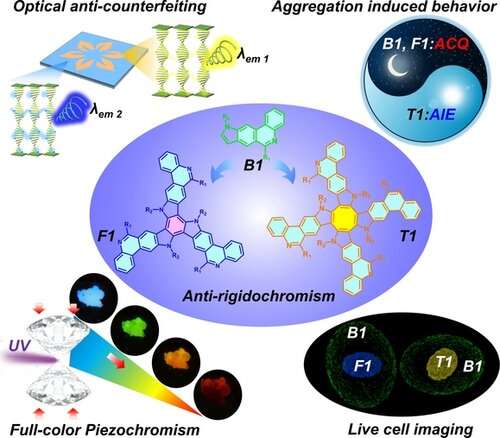This article has been reviewed according to Science X's editorial process and policies. Editors have highlighted the following attributes while ensuring the content's credibility:
fact-checked
peer-reviewed publication
trusted source
proofread
Multiple-responsive fluorescent probes developed for microenvironmental monitoring

Fluorescent probes capable of monitoring multiple analytes/parameters of microenvironments are attractive in the field of disease diagnosis, intracellular imaging, material defects tracking, and high-resolution sensing. However, most reported fluorophores can only detect one or few analytes/parameters. Developing a versatile fluorescent probe for diverse microenvironmental monitoring remains a challenge.
In a study published in Angewandte Chemie International Edition, the research group led by Prof. Huang Weiguo from Fujian Institute of Research on the Structure of Matter of the Chinese Academy of Sciences developed a new class of configuration-induced multichromism fluorophores with multiple responses to the external information.
The researchers designed and synthesized three phenanthridine-based fluorophores (i.e., B1, F1 and T1 with 1D, 2D and 3D molecular configuration, respectively) capable of monitoring various microenvironments. B1 and F1 with a respective 1D linear and 2D planar molecular configuration exhibit typical aggregation-caused quenching (ACQ) behavior, while T1 possessing a dynamic saddle-shaped configuration serves as an AIEgen.
They found that these three fluorophores could effectively respond to the viscosity, rigidity, and aggregated state change of microenvironments. Upon compression, all fluorophores give red-shifted emissions with decent recoveries. In particular, the emission peak of F1 shifts from 465 nm to 628 nm in going from 0.00 GPa to 17.50 Gpa, showing an overall redshift of 163 nm and a fluorescence color evolution of blue, green, yellow, orange, and red, leading to an organic fluorophore-based full-color piezochromism.
The researchers revealed that the configurational differences of three fluorophores also vary their photophysical properties under external mechanical pressures. To gain the relationship between photophysical properties and the applied pressure, they studied the piezochromic luminescence properties of B1, F1, and T1 under controlled hydrostatic pressure via the use of a diamond anvil cell (DAC).
Additionally, by manipulating the incubation time in live cell imaging, the researchers found that B1 mainly stains the cytoplasm, whereas F1 and T1 selectively concentrate in cell nucleus, and the nucleus-targeting staining performance of F1 is better than the commercial 4′,6-diamidino-2-phenylindole (DAPI) probe.
This study provides a general design strategy of versatile fluorophores capable of sensing multiple analytes/parameters in diverse microenvironments.
More information: Wei Huang et al, Configuration‐Induced Multichromism of Phenanthridine Derivatives: A Type of Versatile Fluorescent Probe for Microenvironmental Monitoring, Angewandte Chemie International Edition (2023). DOI: 10.1002/anie.202219337
Journal information: Angewandte Chemie International Edition
Provided by Chinese Academy of Sciences



















